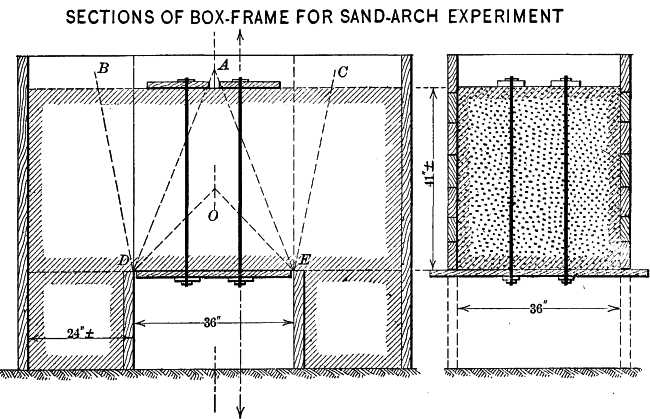AMERICAN SOCIETY OF CIVIL ENGINEERS
INSTITUTED 1852
TRANSACTIONS
Paper No. 1174
PRESSURE, RESISTANCE, AND STABILITY OF EARTH.[A]
By J.C. Meem, M. Am. Soc. C. E.
With discussion by Messrs. T. Kennard Thomson, Charles E. Gregory,Francis W. Perry, E.P. Goodrich, Francis L. Pruyn, Frank H. Carter, andJ.C. Meem.
In the final discussion of the writer's paper, "The Bracing of Trenchesand Tunnels, With Practical Formulas for Earth Pressures,"[B] certainminor experiments were noted in connection with the arching propertiesof sand. In the present paper it is proposed to take up again thequestion of earth pressures, but in more detail, and to note somefurther experiments and deductions therefrom, and also to consider theresistance and stability of earth as applied to piling and foundations,and the pressure on and buoyancy of subaqueous structures in softground.
In order to make this paper complete in itself, it will be necessary, insome instances, to include in substance some of the matter of the formerpaper, and indulgence is asked from those readers who may note thisfact.
Experiment No. 1.—As the sand-box experiments described in the formerpaper were on a small scale, exception might be taken to them, andtherefore the writer has made this experiment on a scale sufficientlylarge to be much more conclusive. As shown in Fig. 1, wooden abutments,Pg 3533 ft. wide, 3 ft. apart, and about 1 ft. high, were built and filledsolidly with sand. Wooden walls, 3 ft. apart and 4 ft. high, were thenbuilt crossing the abutments, and solidly cleated and braced frames wereplaced across their ends about 2 ft. back of each abutment. A falsebottom, made to slide freely up and down between the abutments, andprojecting slightly beyond the walls on each side, was then blocked upsnugly to the bottom edges of the sides, thus obtaining a box 3 by 4 by7 ft., the last dimension not being important. Bolts, 44 in. long, withlong threads, were run up through the false bottom and through 6 by 15by 2-in. pine washers to nuts on the top. The box was filled withordinary coarse sand from the trench, the sand being compacted asthoroughly as possible. The ends were tightened down on the washers,which in turn bore on the compacted sand. The blocking was then knockedout from under the false bottom, and the following was noted:
As soon as the blocking was removed the bottom settled nearly 2 in., asnoted in Fig. 1, Plate XXIV, due to the initial compacting of the sandunder the arching stresses. A measurement was taken from the bottom ofthe washers to the top of the false bottom, and it was noted as 41 in.(Fig. 1). After some three or four hours, as the arch had not beenbroken, it was decided to test it under greater loading, and four menwere placed on it, four others standing on thePg 354 haunches, as shown inFig. 2, Plate XXIV. Under this additional loading of about 600 l
